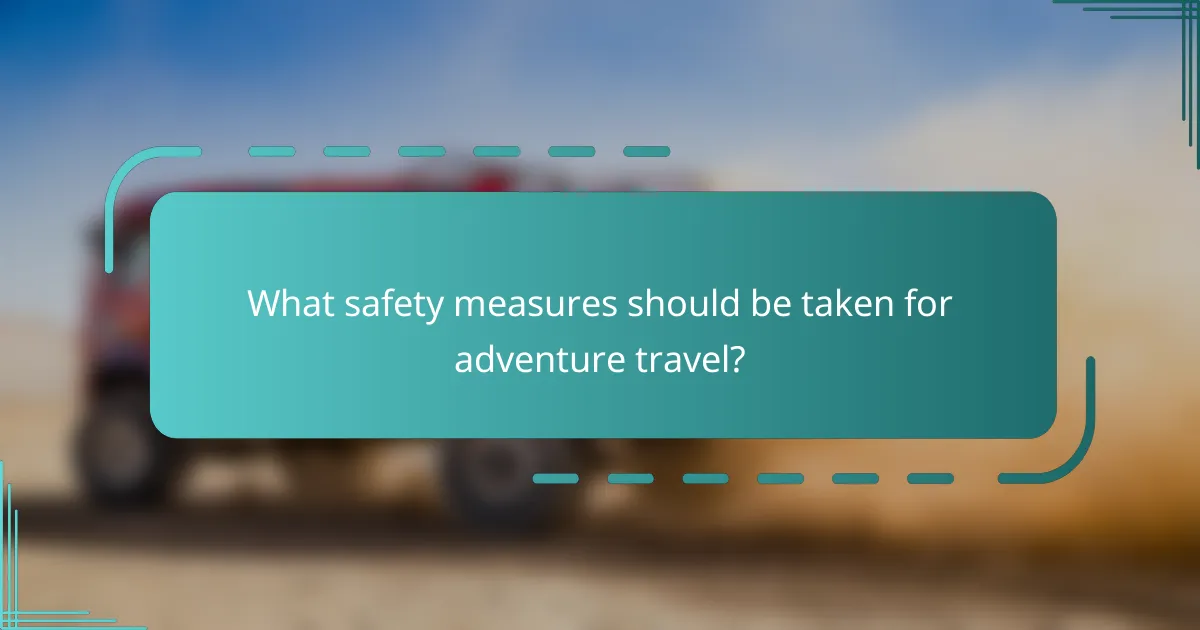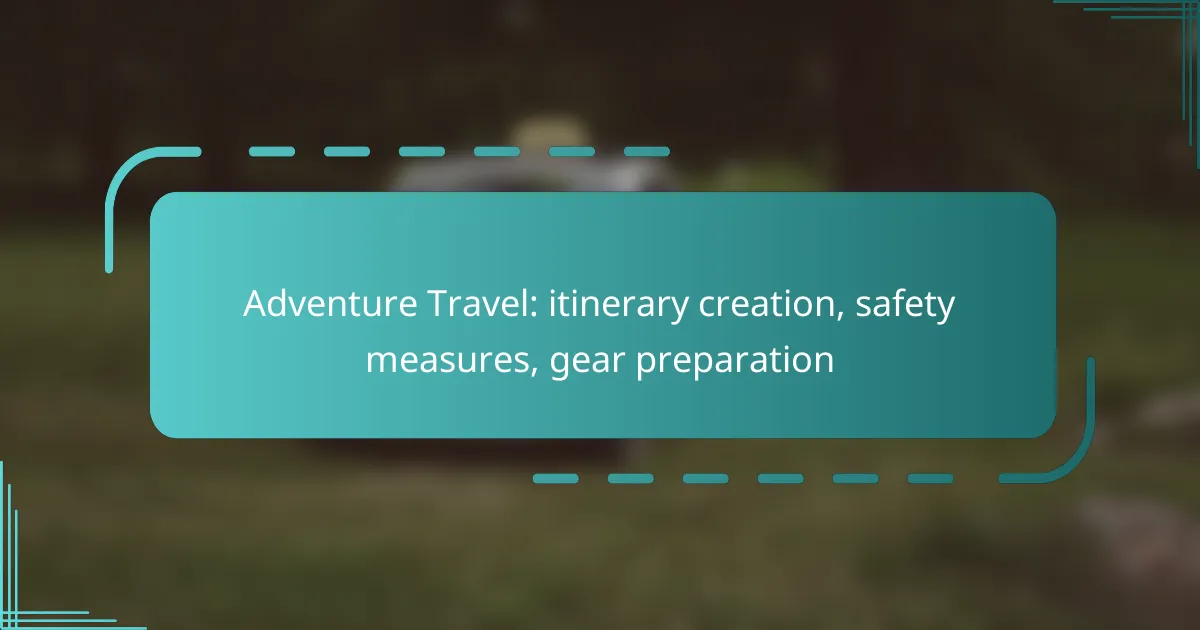Embarking on an adventure travel journey requires careful planning and preparation to ensure a rewarding experience. From creating a detailed itinerary that outlines your goals and activities to prioritizing safety measures and selecting the right gear, each step is vital for a successful trip. By focusing on these elements, you can maximize enjoyment while minimizing risks and challenges along the way.

How to create an adventure travel itinerary?
Creating an adventure travel itinerary involves outlining your travel goals, selecting destinations, planning activities, setting a budget, and establishing a timeline. This structured approach ensures a well-organized trip that maximizes enjoyment and minimizes stress.
Define travel goals
Start by identifying what you want to achieve during your adventure. Are you seeking relaxation, exploration, cultural experiences, or physical challenges? Defining clear goals helps shape the rest of your itinerary.
Consider the type of adventure you prefer, such as hiking, kayaking, or cultural immersion. This will guide your destination choices and activity planning.
Select destinations
Choose destinations that align with your travel goals. Research various locations based on their adventure offerings, accessibility, and safety. Popular adventure travel spots include national parks, mountain ranges, and coastal regions.
Factor in travel restrictions or requirements, such as visas or vaccinations, especially for international destinations. This ensures you can enter your chosen locations without complications.
Plan activities
Once you have your destinations, outline specific activities for each location. Consider guided tours, local experiences, or self-directed adventures. Balance high-energy activities with downtime to avoid burnout.
Make reservations for popular activities in advance, especially during peak seasons. This can include guided hikes, scuba diving lessons, or cultural workshops.
Set a budget
Establish a budget that covers transportation, accommodation, activities, food, and emergency funds. Research average costs for your chosen destinations to create a realistic financial plan.
Consider using a budgeting app or spreadsheet to track expenses. This helps prevent overspending and allows for adjustments if necessary.
Establish a timeline
Create a timeline that outlines when you will travel, how long you will stay in each location, and the timing of activities. This helps ensure you make the most of your time without feeling rushed.
Be flexible with your timeline to accommodate unexpected changes, such as weather conditions or local events. A well-structured yet adaptable schedule enhances your adventure experience.

What safety measures should be taken for adventure travel?
Prioritizing safety measures is crucial for adventure travel to minimize risks and ensure a successful experience. Key steps include researching local conditions, obtaining necessary permits, packing a first-aid kit, sharing your itinerary, and staying updated on weather forecasts.
Research local conditions
Understanding local conditions is essential for safe adventure travel. This includes checking terrain, wildlife, and potential hazards specific to the area you plan to visit. For instance, if hiking in mountainous regions, be aware of altitude sickness and trail difficulty.
Additionally, familiarize yourself with local customs and regulations. Some areas may have restrictions on certain activities, such as camping or fire usage, which can impact your plans.
Obtain necessary permits
Many adventure activities require permits to ensure safety and environmental protection. Research the specific permits needed for your destination, which can vary widely by location and activity type. For example, national parks often require permits for backcountry camping or climbing.
Apply for these permits well in advance, as they may have limited availability. Check local government websites for detailed information on application processes and fees, which can range from a few dollars to several hundred depending on the activity.
Pack a first-aid kit
A well-stocked first-aid kit is a vital component of your adventure gear. Include essentials such as adhesive bandages, antiseptic wipes, gauze, and pain relievers. Tailor your kit to the specific activities you plan to undertake; for example, include blister treatment for long hikes.
Regularly check and replenish your kit before each trip. Familiarize yourself with how to use each item, and consider taking a basic first-aid course to enhance your preparedness.
Share itinerary with someone
Sharing your itinerary with a trusted friend or family member is a simple yet effective safety measure. Provide details such as your planned route, expected return time, and emergency contacts. This ensures someone knows your whereabouts in case of an emergency.
Consider using apps that allow real-time location sharing, which can provide additional peace of mind for both you and your contacts during your adventure.
Stay updated on weather
Weather conditions can change rapidly in many adventure travel destinations, making it crucial to stay informed. Check forecasts regularly leading up to your trip and during your activities. Use reliable weather apps or websites that provide real-time updates.
Be prepared to adjust your plans based on weather changes. For instance, if thunderstorms are forecasted, it may be wise to postpone a hike or seek shelter in advance. Always have contingency plans in place for adverse weather conditions.

What gear is essential for adventure travel?
Essential gear for adventure travel includes clothing suitable for various climates, navigation tools, camping equipment, safety gear, and hydration systems. Selecting the right gear ensures comfort, safety, and preparedness for unexpected situations during your journey.
Clothing for varying climates
Your clothing should adapt to the climate conditions you expect to encounter. For cold weather, layering is key; consider thermal base layers, insulating mid-layers, and waterproof outer layers. In warmer climates, lightweight, moisture-wicking fabrics will help keep you cool.
Always pack a versatile jacket that can handle rain and wind, regardless of the forecast. Quick-dry pants and breathable shirts are also beneficial for comfort and functionality.
Navigation tools
Reliable navigation tools are crucial for adventure travel. A good-quality map and compass should be part of your essentials, even if you plan to use GPS devices. Familiarize yourself with how to read maps and use a compass before your trip.
Smartphone apps can enhance navigation but ensure you have offline maps available in case of poor signal areas. A portable power bank can keep your devices charged while on the move.
Camping equipment
When camping, a lightweight tent, sleeping bag, and sleeping pad are fundamental. Choose a tent that suits the number of occupants and is appropriate for the weather conditions you expect.
Consider a portable stove for cooking and a compact cooking set that includes pots and utensils. Always check local regulations regarding campfires and waste disposal to minimize your impact on the environment.
Safety gear
Safety gear is non-negotiable in adventure travel. A first aid kit tailored to your activities should include bandages, antiseptics, and any personal medications. A whistle and a multi-tool can also be invaluable in emergencies.
Consider carrying a personal locator beacon (PLB) or satellite messenger for remote areas where cell service is unavailable. Always inform someone of your itinerary and expected return time.
Hydration systems
Staying hydrated is vital during any adventure. A hydration pack or water bottles that can hold at least 2-3 liters are recommended for day hikes. Ensure your water containers are durable and easy to carry.
Portable water filters or purification tablets can help ensure safe drinking water from natural sources. Always plan your water sources ahead of time, especially in arid regions.

What are the best adventure travel destinations in North America?
North America boasts a variety of adventure travel destinations that cater to outdoor enthusiasts. Key locations include national parks known for their stunning landscapes, diverse activities, and opportunities for exploration.
Yosemite National Park
Yosemite National Park in California is renowned for its breathtaking granite cliffs, waterfalls, and giant sequoias. Popular activities include rock climbing, hiking, and photography, with trails ranging from easy walks to challenging climbs.
When planning a visit, consider the best times to go, typically spring and fall, to avoid crowds and enjoy mild weather. Be aware of park regulations, such as camping permits and wildlife safety guidelines.
Banff National Park
Located in Alberta, Canada, Banff National Park offers stunning mountain scenery and a wealth of outdoor activities. Visitors can enjoy skiing in the winter, hiking in the summer, and soaking in natural hot springs year-round.
For a successful trip, secure accommodations early, especially during peak seasons. Familiarize yourself with local wildlife, including bears, and always follow safety protocols when exploring the backcountry.
Grand Canyon
The Grand Canyon in Arizona is a must-visit for adventure seekers, famous for its vastness and unique geological formations. Hiking, rafting, and helicopter tours provide various ways to experience this natural wonder.
Plan your visit around the cooler months, as summer temperatures can be extreme. Ensure you have adequate supplies, including water and sun protection, and consider guided tours for a safer experience in remote areas.

How to choose the right adventure travel insurance?
Selecting the right adventure travel insurance is crucial for safeguarding against unexpected events during your trip. Look for policies that cover activities you plan to engage in, such as hiking, climbing, or water sports, and ensure they provide adequate medical coverage and evacuation options.
Understand the coverage options
Adventure travel insurance typically includes several coverage options such as medical expenses, trip cancellation, lost luggage, and emergency evacuation. Review these options carefully to ensure they align with your travel plans and activities. For instance, if you plan to go rock climbing, confirm that your policy covers injuries related to that activity.
Check for exclusions
Every insurance policy has exclusions that outline what is not covered. Common exclusions in adventure travel insurance may include pre-existing conditions, certain high-risk activities, or travel to specific regions. Read the fine print to avoid surprises, especially if you are traveling to remote areas or engaging in extreme sports.
Compare policies and prices
When choosing adventure travel insurance, compare multiple policies to find the best balance of coverage and cost. Prices can vary significantly based on the level of coverage, the duration of your trip, and your age. Use comparison websites to evaluate different options and look for customer reviews to gauge reliability.
Consider your destination
Your travel destination can influence the type of insurance you need. For example, if you are traveling to a country with high medical costs or limited healthcare facilities, opt for a policy with higher medical coverage. Additionally, some countries may require proof of insurance for entry, so check local regulations before you travel.
